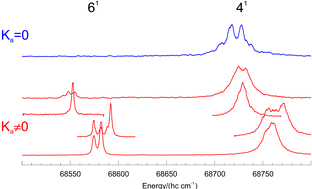The rotational structure of the lowest three vibrational levels (00, 61 and 41) of the 3px 1A2 Rydberg state of formaldehyde has been studied by doubly-resonant three-photon ionization spectroscopy. A strong a-type Coriolis interaction between the in-plane rocking (ν6) and out-of-plane bending (ν4) modes results in the observation of vibronically forbidden transitions to the 61 level from the intermediate à 1A2 (21 43) level. The full widths at half maximum of the rovibronic transitions to the 41 state are considerably larger than to the vibrational ground state and the 61 level. The band origin (T0 = 67 728.939(82) cm−1), the rigid rotor rotational constants (A = 9.006(19) cm−1, B = 1.331(20) cm−1, and C = 1.135(22) cm−1), the Coriolis coupling constant (ξa4,6 = 8.86(89) cm−1) and the deperturbed fundamental wave numbers of both vibrational modes (ṽ6 = 808.88(25) cm−1 and ṽ4 = 984.92(26) cm−1) have been determined for the 3px 1A2 Rydberg state. Polarization effects originating from the double-resonance technique have been exploited to detect the Coriolis interaction and investigate how it affects the predissociation dynamics.

You have access to this article
 Please wait while we load your content...
Something went wrong. Try again?
Please wait while we load your content...
Something went wrong. Try again?


 Please wait while we load your content...
Please wait while we load your content...